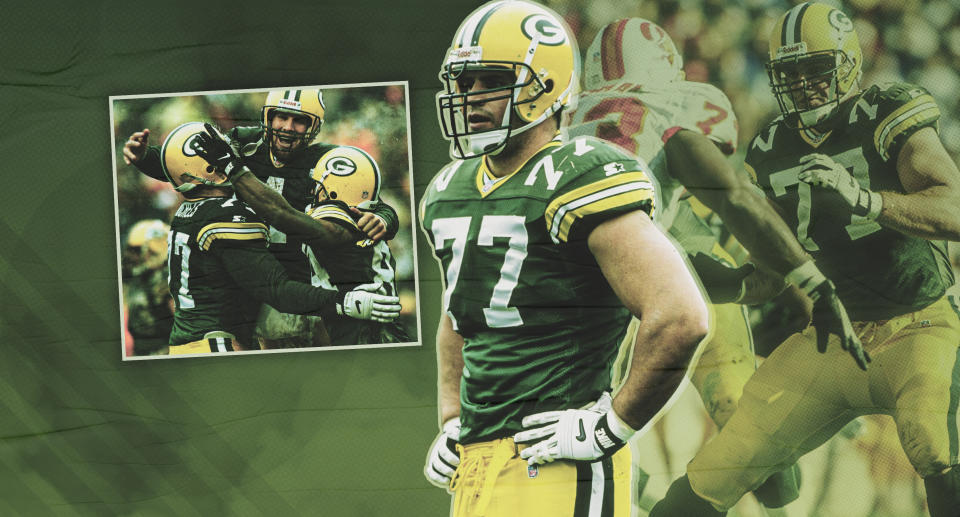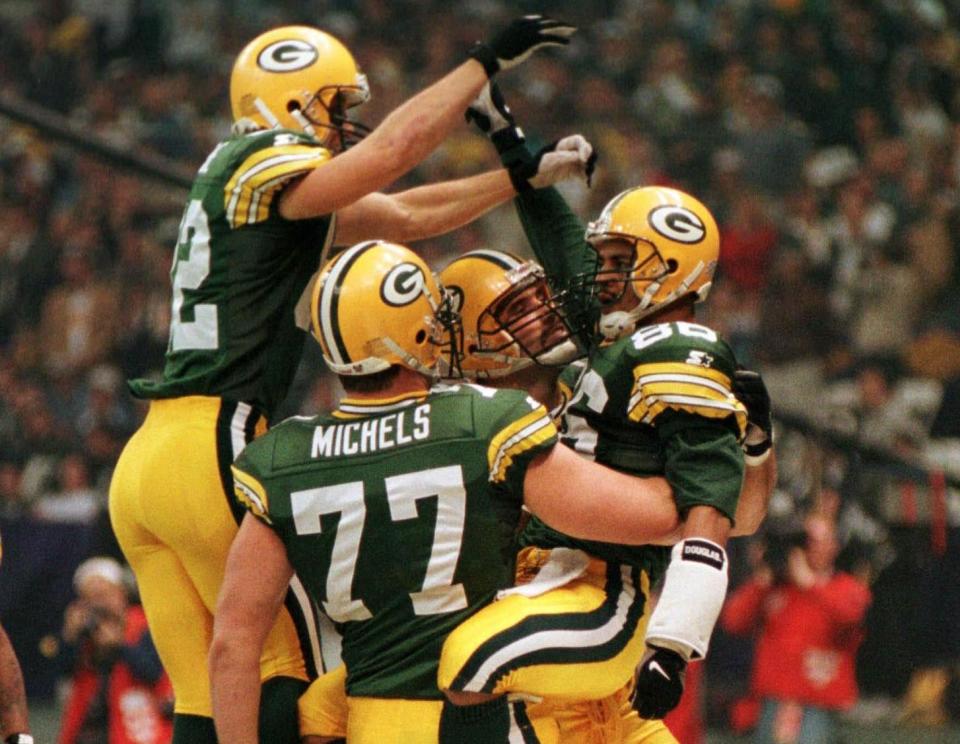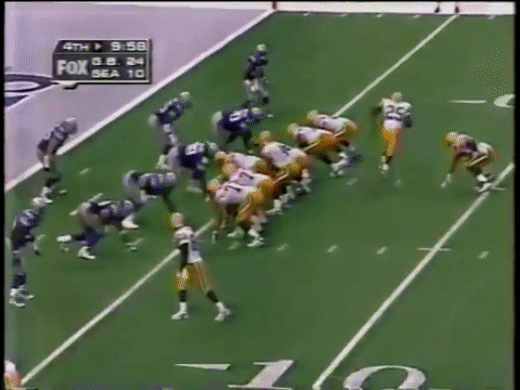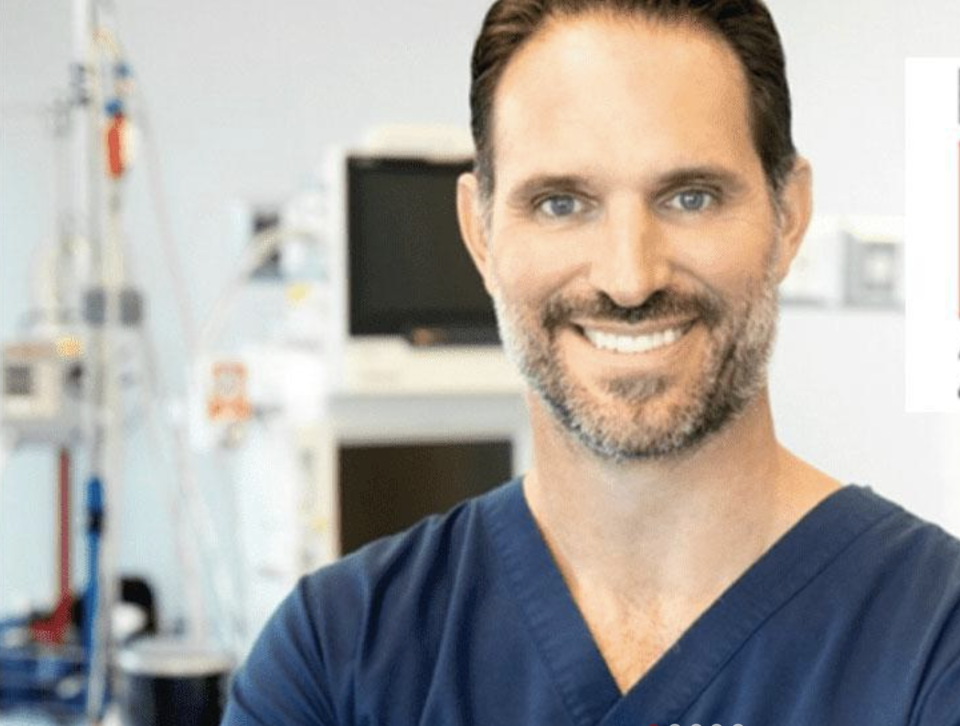Moment of Glory: Packers' John Michels now treats others who suffered the way he did
John Michels knows he’s the answer to a trivia question, and one that doesn’t cast his NFL career in the brightest of lights.
In the 1996 NFL draft, the Green Bay Packers were shocked that a University of Miami linebacker they loved was on the board a few picks away from their selection at No. 27. When the Philadelphia Eagles picked Texas A&M-Kingsville offensive lineman Jermane Mayberry 25th overall, then-Packers GM Ron Wolf picked up the phone.
Wolf called Ray Lewis, the apple of his draft eye. A dream situation was unfolding for Green Bay.
The Packers had Lewis as their top-rated linebacker in the draft, even ahead of No. 2 overall pick Kevin Hardy. Lewis had character concerns coming out of Miami, but the Packers felt Lewis was a rare talent whose issues wouldn’t be a concern on a veteran Green Bay defense mentored by Reggie White and LeRoy Butler.
But the Packers were crushed when the Baltimore Ravens, in their first year of existence, sniped Lewis one pick before them. Green Bay needed to pivot — quickly. Wolf instead picked Michels, the USC offensive tackle who replaced Tony Boselli with a strong senior season.
Wolf’s disappointment over losing Lewis was hard to hide. But he and the Packers felt Michels was a good prospect, one who was slated to replace 12-year veteran Ken Ruettgers at left tackle eventually.

The plan fell apart. Injuries derailed Michels’ NFL career, despite a promising start during their Super Bowl-winning run as a rookie.
“That’s turned out to be Ron Wolf’s greatest regret,” Michels told Yahoo Sports recently by phone, with a laugh. Michels has maintained his sense of humor despite his playing career being far shorter than anyone imagined, along with the cruel label of “bust” almost universally applied by fans.
Since then, Michels went through rounds of surgeries and rigorous, excruciating rehab that far outlasted his football career. He even dabbled in ministry before eventually ending up 20 years later with a career in medicine.
In a lot of ways, Michels becoming a pain-management doctor has not only led to him healing many others who suffered physical pain — the way he did for many years — but it also helped put the proper perspective on his own abbreviated NFL career.
“There are people who suffer pain that prevents them from being able to do the things they want to do,” Michels said. “That was the case for me, and I didn’t want anyone else to have to suffer in that way.”
From Trojans backup to first-round pick
Michels came to USC as a defensive end, backing up Willie McGinest for two years. But when Tony Boselli, the Trojans’ standout left tackle, got hurt in 1994, the coaches moved Michels to offensive line. McGinest was picked fourth overall in the 1994 draft, and Boselli was the No. 2 overall pick the following year.
Michels said his time as an understudy to two legends served him well.
“Those two guys taught me how to compete,” Michels said. “[They said] you can’t just do your job. You have to go out and dominate your opponent. Block your guy 10 yards down the field. Don’t let up. Demoralize your opponent.”
When Michels shut down Arizona’s Tedy Bruschi, the eventual Pac-10 Defensive Player of the Year and NCAA all-time sack co-leader with 52, NFL scouts started paying close attention. At nearly 6-foot-7, Michels had textbook length — even if he was light at 280 pounds — and excellent athleticism.
“Tedy was so highly respected and a great player,” Michels said. “For me to go into Arizona and hold him in check, people were asking, ‘Who is this guy who replaced Boselli?’”
After strong performances at the Senior Bowl and the NFL scouting combine, Michels went from “maybe a second- or third-rounder” in his mind to a possible late Round 1 prospect.
“That’s when it sunk in,” he said. “I was a bit shocked, like ... could this actually happen?”
Michels was the latest in a long line of Round 1 USC offensive linemen, following former teammates Pat Harlow (1991) and Boselli (1995). The man Michels was pegged to eventually replace, Ruettgers, was a Trojans first-rounder 11 years earlier.
“The plan was to have me learn from this great veteran, knowing I had only one year of starting experience,” Michels said. “But it didn’t really go that way ... for Ken or me.”

Thrown into starting lineup for Super Bowl team
Ruettgers’ degenerative knee acted up in training camp, and the Packers’ best-laid plans fell apart. They had an offense, led by Brett Favre, that ranked sixth in the league in scoring in 1995 and looked to be even better in 1996. But when Ruettgers was unable to play in the preseason, Michels was thrown into the fire for a Super Bowl contender.
Michels started Green Bay’s preseason opener and was on track to be the Week 1 left tackle. But ankle and back injuries in the third preseason game set him back, and he gave way to third-year vet Gary Brown. After Favre was sacked seven times in a Week 4 loss to the Minnesota Vikings, head coach Mike Holmgren tabbed a now-healthy Michels to replace him.
His first start came in Seattle against a Seahawks defense that had 11 sacks the previous three games. By season’s end, the Seahawks would rank second in sack percentage, led by Mike McCrary (13.5 sacks) and Michael Sinclair (13).
Michels drew McCrary that game and held him to two tackles and no sacks. Looking back, Michels felt it was his best game as a Packer.
“It also happened to be on my Mom’s birthday, which made it especially memorable,” he said. “I was able to fulfill a childhood promise of buying her a car. I surprised her with the key after the game.
“It was one of the most awesome experiences you could imagine.”
Favre made one of his signature plays in that game — an ad-libbed TD flip pass. You can see Michels blocking for him on the improvisational throw.

The knee that just couldn’t stay healthy
Michels started the next game against the Chicago Bears but was knocked out early after a defender fell on his leg. Despite suffering torn ligaments, Michels returned to the lineup two weeks later, starting six of the final eight games, giving way once each to Ruettgers and Bruce Wilkerson.
“You were expected to play hurt,” Michels said. “I remember Holmgren asking us, ‘Are you hurt? Or are you injured?’ You just fought through it.”
But by the playoffs, Holmgren made a call that hurt Michels. With Ruettgers not healthy enough to play, Holmgren turned to Wilkerson at left tackle. Per Chuck Carlson’s “Tales From The Packers Sidelines” book, Holmgren said: “I needed to be sure at that position, and I wasn’t.”
Amazingly, the Packers started four different left tackles en route to winning the Super Bowl that season. Michels, the respectful rookie, was wasn’t about to divide the locker room by expressing his disappointment over not starting.
“Watching Brett and Reggie White, our leaders, they really never let their egos get in the way of anything,” Michels said. “Why that team was great, other than the incredible talent, was because we were very close as a team. That’s what made that team so special.”
Michels started the first five games at left tackle in 1997. But he suffered a knee sprain in Week 4 and another tear in Week 5 — both in the same right knee he’d hurt before, missing the Packers’ Super Bowl run that season.
Yet he still felt he could fight through the pain.
In training camp in 1998, Michels’ battered knee completely fell apart. Following a preseason loss at Oakland, an angry Holmgren ordered his charges to practice in full pads on rain-soaked fields. In a pass-rush drill against Vonnie Holliday, Michels was pulled down in a horrifically awkward way.
“I tore all my ligaments. All the cartilage was shredded. And I had a quarter-sized chunk taken out of my femur, right above my patella,” Michels recalled. “That’s what pretty much ended my career.”
Since that day more than 20 years ago, Michels still has never been able to go running.
“Not even for a few blocks,” he said. “Hurts too much.”
Michels returned in 1999 but still wasn’t right. Unable to practice consecutive days in training camp, Michels was traded to the Philadelphia Eagles.
“I just hoped the knee could hold up for a season,” Michels said, “and that maybe it was a fresh start.”
After one preseason game in Philly, Michels said he could barely stand up in the shower because of the pain. He was cut a few weeks later.
Michels had another surgery back at USC shortly after that, diving back into rehab. Even though the pain didn’t subsist, he actually got another few tryouts that year.
Jack Elway, John’s father and then a scout for the Denver Broncos, worked out Michels. After he ran a gimpy 40-yard dash, the elder Elway turned to Michels and said: “You’ve got a hitch in your giddy-up.”
Michels tried to blow it off. The Tampa Bay Buccaneers also brought him in for a workout prior to the playoffs. Nothing changed; Michels still couldn’t run.
The following offseason, Michels underwent microfracture surgery — a brand new procedure then. When that didn’t promote the cartilage growth that was hoped for, Michels repeated the procedure twice with former Broncos team doctor Dr. Richard Steadman. He’d eventually undergo six surgeries on his right knee.
“At that point, thankfully, I had the recognition that it just wasn’t going to happen,” he said.
A new career — and a new perspective on pain
Michels took stock of his life and tried to form a plan. Inspired by Reggie White, his former teammate and next-door neighbor in Green Bay, Michels served as a youth minister in Mission Viejo, California, for two years during his last two rehab stints.
But he felt inadequate as a pastor, having been around a few truly inspirational ones in his life, and didn’t feel he could ever be great at it. Michels also got his pilot’s license and even kicked around the idea of breaking into sports broadcasting.

In the end, however, the desire to help people overcome the pain he endured for years pulled Michels toward a career in medicine.
“I didn’t want people suffering the way I had,” he said. “I wanted to pour everything I had into that and be the best doctor I could.”
A religious studies major in college, Michels needed to complete several core science classes before he could even apply to med school. He accomplished both at USC, first completing a post-baccalaureate pre-med program and then finishing med school there.
Michels was pegged as a future orthopedic surgeon. He liked the idea, but during his first orthopedic rotation — a 4.5-hour hip replacement — Michels could barely stand. Once more, the painful knee was keeping him from his professional dreams.
But during a research project on interventional radiology, Michels was inspired by the rapid advancements in that field through more minimally invasive procedures. His thinking: If that approach could be applied to putting stents in for brain aneurisms and liver biopsies, why couldn’t it be done for injuries like the ones he’d suffered from?
Michels completed his residency as a radiologist, ending up an interventional pain management specialist who treats patients with chronic pain. All Michels needed for inspiration for endorsing less invasive methods were the massive scars on his own body.
“I have a big zipper over my right knee,” he said. “I’ve got a zipper on my left shoulder, a couple of zippers where I had a sports hernia fixed. I’ve had eight operations in my life, all of them pretty major, and I’ve got eight reminders right on my flesh.”
Michels now works in Dallas at Interventional Spine and Pain. It took him more than 12 years, from 2002-14, to complete his training. Early on in that process, Michels called up Ruettgers, still one of his closest friends today, bemoaning how long his training would take.
“I said, ‘Ken, I am going to be over 40 when I get through with this,’” Michels said. “He said, “John, you’re going to be 40 either way, so you might as well become a doctor.’”
And now, nearly 25 years after being drafted by a Super Bowl-winning team, Michels has reached a peak of an accomplishment he never could have imagined then.
“My original plan was to play football for 15, 20 years, win a few Super Bowls and retire before going into the ministry,” he said. “It’s funny how life takes you places you never dreamed of. A big sense of accomplishment came from how long that path took to get here.
“But the biggest reward now is I see some people in my practice who are in tremendous pain, maybe the worst of their life, and being able to look at them and say, ‘I understand,’ and them knowing I understand, especially when I tell them what I’ve been through,” he said.
Michels sees everyone from athletes to Average Joes in clinic. To the people he treats, Michels is not viewed as an NFL bust. He’s often seen as a miracle worker.
“It’s been an incredible journey to get to this point,” Michels said. “I don’t regret a thing about it.”
More from Yahoo Sports:


